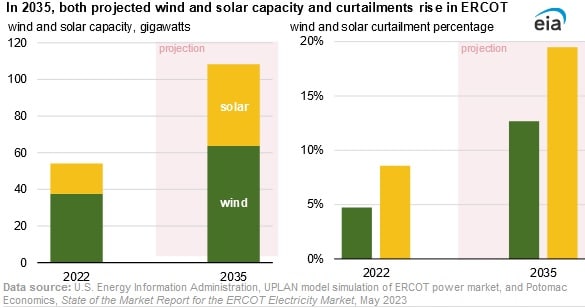Texas’ Wind and Solar Capacity Projected to Double by 2035: EIA

The combined wind and solar generation capacity in Texas is projected to double by 2035, leading to a significant growth of renewables in the total generation mix, according to a July 13 report from the U.S. Energy Information Administration. The growth in renewable generation is in line with the state’s objectives. In 2005, the state legislature proposed the Texas Competitive Renewable Energy Zone, or CREZ, initiative to assist the enhancement of renewable energy, primarily wind production.
Despite the fulfilment of state objectives, Texas can only benefit from this increasing share of wind and solar in the generation mix, if ERCOT expands its electrical transmission network and storage capacity. In the absence of upgrades to the state’s transmission system, wind and solar generation will progressively be curtailed, due to both inept transmission capacity and excessive generation during high availability phases of variable renewable generation.
Analysis by the EIA reveals the amount of variable renewable capacity in ERCOT in 2035 could extensively reduce net load, which refers to the variance between electricity demand and accessible renewable generation at a given point in time. If excessive wind and solar generation is available for production than can be utilised by the grid, then operators would have to restrict wind and solar generation, in order to keep the grid balanced. ERCOT curtailed 5 percent of its total available wind production and 9 percent of total solar generation in 2022. These figures could increase to 13 percent and 19 percent, respectively by 2035.
These curtailments could be reduced by developing the transmission systems, an example being battery charging, which would increase demand and therefore reduce renewable energy production restrictions.
EnerKnol Pulses like this one are powered by the EnerKnol Platform—the first comprehensive database for real-time energy policy tracking. Sign up for a free trial below for access to key regulatory data and deep industry insights across the energy spectrum.
ACCESS FREE TRIAL